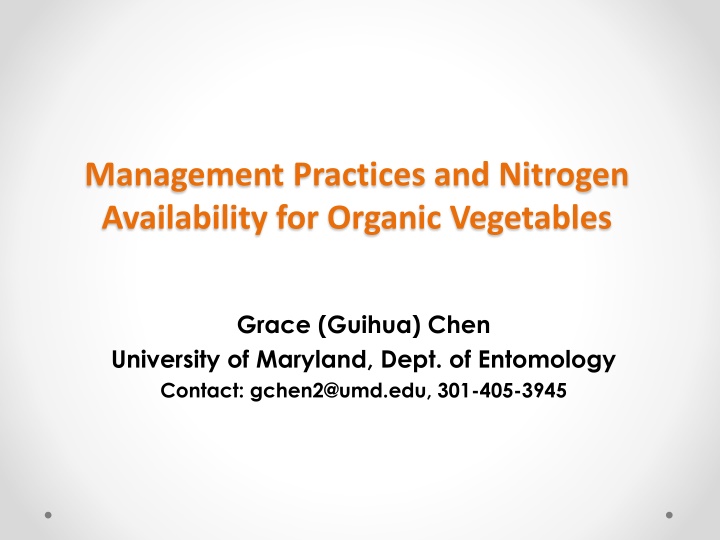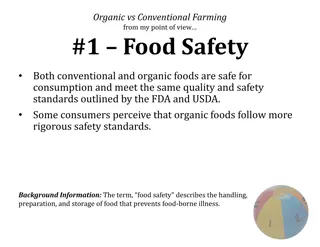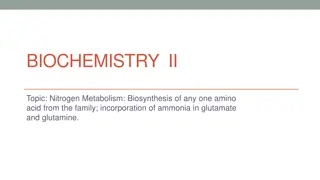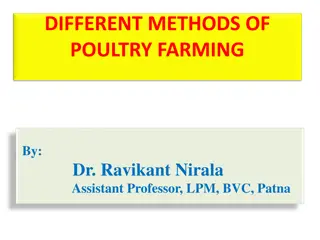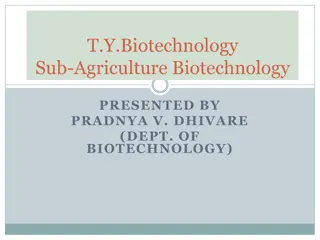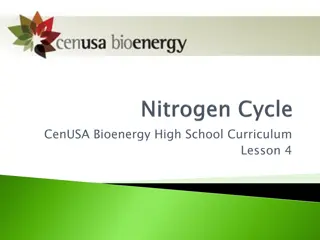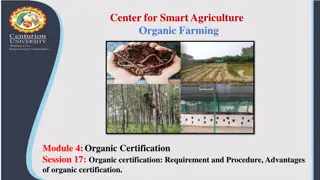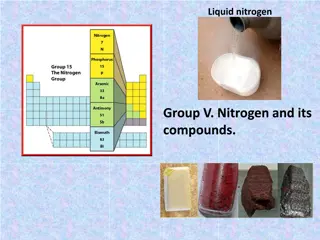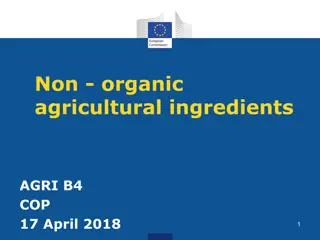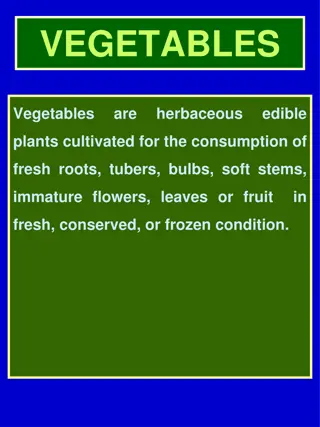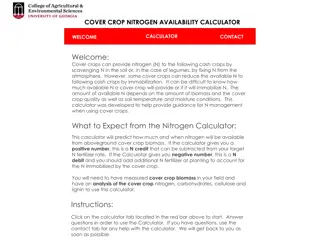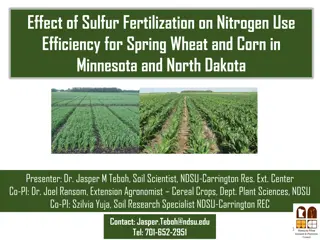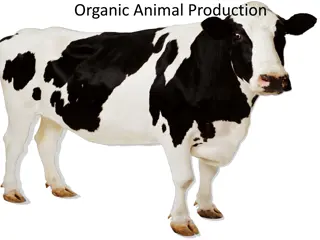Managing Nitrogen Availability for Organic Vegetables
Challenges and strategies to synchronize plant available nitrogen with crop demand, discussing the nitrogen cycle, conditions affecting organic nitrogen mineralization, and crop growth dynamics. Solutions for aligning soil nitrogen levels with crop needs are highlighted to optimize organic vegetable production.
Download Presentation

Please find below an Image/Link to download the presentation.
The content on the website is provided AS IS for your information and personal use only. It may not be sold, licensed, or shared on other websites without obtaining consent from the author.If you encounter any issues during the download, it is possible that the publisher has removed the file from their server.
You are allowed to download the files provided on this website for personal or commercial use, subject to the condition that they are used lawfully. All files are the property of their respective owners.
The content on the website is provided AS IS for your information and personal use only. It may not be sold, licensed, or shared on other websites without obtaining consent from the author.
E N D
Presentation Transcript
Management Practices and Nitrogen Availability for Organic Vegetables Grace (Guihua) Chen University of Maryland, Dept. of Entomology Contact: gchen2@umd.edu, 301-405-3945
Challenges to Synchronize Plant Available N with Crop N Demand Plant Available N (PAN) = Mineral Nitrogen (Nmin) (N-NO3- & N-NH4+) in the soil 100 Nutrient (Nminmg kg-1) 100 Nutrient (Nminmg kg-1) B. Slow N release fertilizers A. Rapid N release fertilizers 80 80 60 60 40 40 20 20 0 0 5/1 5/31 6/30 7/30 5/1 5/31 6/30 7/30 Date Date
Crop Growth and Total N demand Cumulative biomass Maturity Cumulative biomass (tons/A) Cumulative N uptake (lb/A) Phase III: N redistribution (slow or no uptake) Maximum Biomass accumulation Maximum leaf area Phase II: Rapid N uptake Rapid linear growth Maximum N uptake Phase I: Slow N uptake Time (day) (Sullivan, et. al., 1999. Oregon State)
Crop Growth and Daily N demand Cumulative biomass Maturity Cumulative biomass (tons/A) Maximum Biomass accumulation Daily N uptake (lb/A) Maximum leaf area Maximum N uptake rate Rapid linear growth Period of rapid N uptake Time (day) (Sullivan, et. al., 1999. Oregon State)
Question How to make soil available N matches with my crop N demand?
The Nitrogen Cycle N input N loss N component Atmospheric N Atmospheric fixation and deposition Crop harvest Commercial fertilizers Animal manure and biosolids Plant residue Runoff Erosion Volatilization Biological fixation Plant Uptake Denitrification Organic N Nitrate N (NO3-) Ammonium N (NH4+) Nitrification Leaching
Conditions Controlling Organic N Mineralization and Immobilization Sources of organic fertilizer: Carbon to nitrogen (C:N) ratio Soil moisture and Temperature Tillage: Changes in soil moisture, temperature and placement of fertilizers Sources of organic fertilizer: Relationships between C:N Ratio and N mineralization
C:N Ratio and N Mineralization Rate Percent of total N mineralized (Plant Available N) after 4 weeks at Temp= 72 F) Source Seabird Guano Pellets (11-10-2.5) Wilbur Ellis 13-0-0 Blood meal Bio-Ggro (8-5-3) fish bone meal Nature's Intent 9-3-4 (feather meal) Wilbur Ellis 10-4.5-0 fish meal Bio-Grow 7-7-2 Concentrate's (soybean meal) X-cel (corn gluten meal) Wilbur-Ellis (3-15-0) bone meal Poultry litter (3.5-2-2) Rabbit manure Yard trimming compost Alfalfa meal (2.5-0-0) Kelp meal %N 15 14 9 9 9 10 8 10 9 3.5 3 1.7 2 1.2 C:N ratio % of total N mineralized 3 4 4 4 4 5 5 5 5 10 11 16 17 27 72 63 61 63 62 58 68 72 58 32 27 5 4 0 (R. Flynn, 2008, New Mexico State University)
C:N Ratio and N Mineralization Rate Relationship between C:N ratio and PAN after 4 weeks (T = 72 F) 80 PAN (% of total N) y = 0.16x2- 7.95x + 95.02 R = 0.97 60 40 20 0 -20 0 5 10 15 20 25 30 C:N Ratio (Based on data from R. Flynn, 2008, New Mexico State University)
C:N Ratio and N Mineralization Rate C:N Ratio of Cover Crops Residues and N Mineralization / Immobilization Immobilization Mineralization Neutral N Immobilization Microbes tie up N from soil N mineralization Microbes release excess N to soil Low N content High N content C:N Ratio 5:1 10:1 15:1 20:1 30:1 40:1 Clovers Peas Radish Canola Cereal rye, triticale Annual ryegrass Oats (C. White, 2014. Penn State Univ.)
C:N Ratio and N Mineralization Rate When to terminate my cover crops? 100 Vegetative Bud Legume PAN from cover crops (lb/A) 80 PAN from cover crop (lb/A) 60 75% legume 40 20 25% legume 0 -20 Tiller Joint Boot Cereal -40 -60 3/1 4/1 5/1 6/1 1/30 3/1 3/31 4/30 5/30 Date of cover crop termination Date of cover crop termination (Source: D.M. Sullivan and N.D. Andrews, 2012, Oregon State Univ.)
Recommendation: Grab some soil samples from your field before planting/transplanting to test %N and C:N ratio (USDA NRCS East National Technology Support Center, Greensboro, NC)
Conditions Controlling Organic N Mineralization and Immobilization Sources of organic fertilizers: Soil moisture and Temperature Soil Moisture and Temperature? Tillage: Changes in soil moisture, temperature and placement of fertilizers
Effects of Temperature on N Mineralization Q10 8 Soil water content at A. 60% field capacity Increasing soil temperature increases N mineralization rate Mineralized N (mg kg-1) 2 6 B. 80% field capacity 4 T = 35 C C. 100% field capacity T = 10 C 0 120 100 80 60 40 Incubation time (days) Moisture (% field capacity) (Gunti as et al., 2012. Eur. J. Soil Biol.)
Effects of Soil Moisture on N Mineralization A. T = 20 C Water content at 60% FC Mineralized N (mg kg-1) 80% FC B. T = 25 C 100% FC No clear clue of mineralized N with changes in moisture C. T = 30 C Incubation time (days) (Gunti as et al., 2012. Eur. J. Soil Biol.)
Conditions Controlling Organic N Mineralization and Immobilization Sources of organic fertilizers: Soil moisture and Temperature Tillage: Tillage Effects? Changes in soil moisture, temperature and placement of fertilizers
Tillage Increases N Mineralization Rate Mineralized N from periodically sampled field soils Chisel plow Strip-till No-till 60 Mineral N (mg N kg-1soil) 50 40 30 20 10 0 24-May 7-Jun 21-Jun 5-Jul 19-Jul 2-Aug 16-Aug Date (Chen, et al., unpublished data, the project funded by USDA-NIFA ORG program)
Tillage Effects on PAN and Crop N Demand Chisel plow Strip-till No-till 60 Mineral N (mg N kg-1soil) PAN 50 1. PAN matched eggplant N demand 40 30 20 10 0 24-May 7-Jun 1.2 2. Potential N loss in CP and ST in early growing stage? Eggplant plant size 21-Jun 5-Jul 19-Jul 2-Aug 16-Aug Date Plant width (m) 0.8 Chisel plow 0.4 Strip-till No-till 0.0 24-May 7-Jun 21-Jun 5-Jul 19-Jul 2-Aug 16-Aug (Chen, et al., unpublished data, the project funded by USDA-NIFA ORG program)
Summary 1. Know your crop: the critical period of N uptake and total N demand 2. Know the C:N ratios of your fertilizers 3. Make the right decision: Matching crop N uptake pattern with N release pattern from the fertilizers Low C:N ratio fertilizers: a) low rate at planting (or no application if you have legume cover crops) b) Moderate to high rate at side-dressing b) Applying fertilizers of low C:N ratio may be needed at rapid N uptake period b) Less soil disturbance (from ST and NT) increases your soil organic N pool and productivity 4. Practice strip-till and No-till: High C:N ratio fertilizers: High rate at planting ST has higher yield potential and same N mineralization rate as CP a) a)
